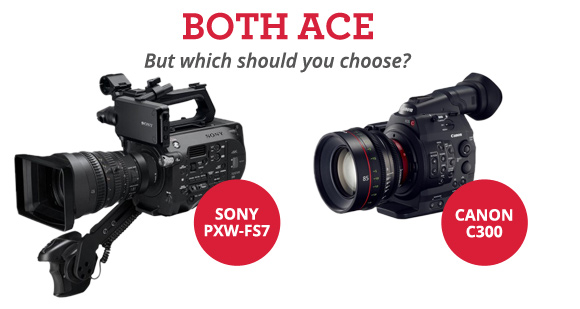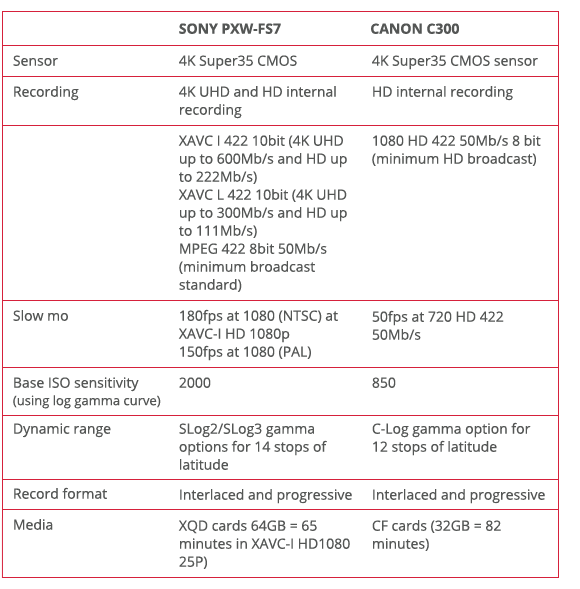Sony PXW-FS7 or Canon C300?
By Colin Coomber – Technical Manager & DoP at Shift 4
June 2015

Canon sparked a revolution in digital cinematography when professionals started using its 5D Mark II DSLR camera for filmmaking, utilizing its surprisingly good 1080p video mode.
Seizing the moment, the manufacturer soon released the EOS C300 camcorder which marked vast moves forward in cinematic HD video production and has since become the workhorse camera of mainstream TV production. It offers the cinematic pictures of the 5D but with audio inputs, timecode and monitor outputs plus other additions that provide full professional video functionality. Delivering stunning pictures with a shallow depth of field at an affordable price and facilitating the use of Canon’s cheaper EF range of lenses, it’s been Shift 4’s most popular hire camera by far for over a year, working across a range of genres.
Competition for the Canon
Sony announced a rival to the C300 at IBC 2014: the PXW-FS7. Offering internal 4K recording, a versatile mount lens system, 150fps in 1080p (PAL) and an extendable hand grip with built-on user function buttons, it’s a clear competitor to the Canon and has a host of superior capabilities. With 14 stops of latitude it’s dynamic range is similar to that of the ARRI ALEXA, a digital cinema camera used for high end features, commercials and dramas. We’re now seeing the FS7 take over work previously covered by the C300. At Shift 4, we have the ARRI AMIRA, ALEXA MINI & ALEXA MINI LF available for hire.
With differing features but a similar hire price tag, is the Canon C300 or the Sony PXW-FS7 the better choice?

Who’s hiring what?
Both cameras have their advantages and disadvantages and, as always with camera choice, it’s important to weigh up the pros and cons of each according to the specific requirements of your production. Whilst many of our clients are being drawn to the newer FS7, a great number are purposely choosing to stick with their old faithful C300.
The versatility of the FS7 lens mount is one of its strengths. Its E mount allows for any lens – PL, EF or B4 mount (with the appropriate adapter) . Having said that, a drawback of the Metabones Adapter (which allows EF lenses to be mounted on the E mount FS7) is that it sometimes results in a slight slowing of the iris control making the camera less responsive. Plus, in general, adapters and lenses occasionally have connection problems rendering it necessary to unmount and then mount again. The C300 comes either as PL mount or EF mount; we find the EF mount model most popular due to the affordability of EF mount lenses. And because EF mount lenses are Canon manufactured, there are no compatibility issues.
Data management, storage and post-production
The FS7 offers the recording of higher resolution pictures and codecs storing more information. All good if you’re looking for higher quality images, but of great significance when it comes to time and money spent in post-production. Larger images with less compression mean more media which, naturally, will affect your data management, storage and post-production processes and costs. Worth bearing in mind also is that XQD cards are notably more expensive to buy and hire than CF cards.
In terms of form factor, the FS7 is slightly larger than the C300 and is marginally better ergonomically, with buttons better placed than on the sometimes awkward C300. The FS7’s handgrip, which features a rocker zoom (compatible with Sony’s 28-135mm E mount lens), iris or ISO control, menu button and joystick, means the camera is much more user-friendly. The XLR audio on the FS7 is better positioned for tidy cabling than on the C300. The LCD screen also has a viewfinder attachment for better use in sunlight. A full FS7 rig is about the same weight as a full C300 rig.
More options but less straightforward
Slow-motion is a common creative technique in mainstream shooting in a wide range of content. The C300 has no high frame rate / high-speed option to compete with 180fps 1080 option on the FS7.
Some feel with FS7’s pictures are more vibrant and “video” whereas the C300 offers more filmic colours. A more filmic look is achievable with the FS7 but only using cinema mode which isn’t suited to run and gun shooting.
So, in conclusion, the FS7 offers many more options than the C300 but, as such, it’s a less straightforward camera to operate. The C300 is an old and steady favourite that presents few problems when using affordable EF lenses. It doesn’t however allow 4K recording.
Coming soon…
Keep in mind the Canon C300 Mark II which is due for release later this year. It features 4K internal recording in a brand new Canon own XF-AVC codec and the ability to output 4KRAW, 1080p/120fps. It records to CF Fast 2.0 media. Canon insists the C300 Mark II will outperform the FS7 despite not having 4K/60 and 1080/180fps. We can’t wait to get our hands on it.
Tuesday, June 30th, 2015